Publications
Antiretroviral treatment adherence as a mediating factor between psychosocial variables and HIV viral load
Antiretroviral treatment adherence as a mediating factor between psychosocial variables and HIV viral load
 Abstract: Psychosocial factors may directly impact HIV health measures such as viral load (VL) whether or not patients are taking antiretroviral treatment (ART) consistently. Structural equation modeling plus Baron and Kenny’s (1986) four-step approach were used to test a mediated model predicting VL among 246 HIV-infected adults who were on ART. Exogenous variables were social support, barriers to adherence, and stress. Moderators were alcohol use, marijuana use, and neurocognitive impairment. A small positive association between marijuana use and ART adherence approached significance. Only barriers to adherence predicted a decrease in adherence rates and an increase in VL. No other factors were significantly associated with either VL or adherence, and no interaction effects between exogenous variables and moderators were identified. The association between barriers to adherence and VL was partially mediated by ART adherence. Findings provide modest support for a direct link between psychosocial variables and a virologic response to ART.
Abstract: Psychosocial factors may directly impact HIV health measures such as viral load (VL) whether or not patients are taking antiretroviral treatment (ART) consistently. Structural equation modeling plus Baron and Kenny’s (1986) four-step approach were used to test a mediated model predicting VL among 246 HIV-infected adults who were on ART. Exogenous variables were social support, barriers to adherence, and stress. Moderators were alcohol use, marijuana use, and neurocognitive impairment. A small positive association between marijuana use and ART adherence approached significance. Only barriers to adherence predicted a decrease in adherence rates and an increase in VL. No other factors were significantly associated with either VL or adherence, and no interaction effects between exogenous variables and moderators were identified. The association between barriers to adherence and VL was partially mediated by ART adherence. Findings provide modest support for a direct link between psychosocial variables and a virologic response to ART.
Attonito, J., Dévieux, J.G., Lerner, B.D., Hospital, M.M., & Rosenberg, R. (2014). Antiretroviral treatment adherence as a mediating factor between psychosocial variables and HIV viral load. Journal of the Association of Nurses in AIDS Care, 25(6), 626-637. doi:10.1016/j.jana.2014.08.001
A randomized controlled trial of Guided Self-Change with minority adolescents
A randomized controlled trial of Guided Self-Change with minority adolescents
 Abstract/Objective: Adolescent substance use and abuse is a pressing public health problem and is strongly related to interpersonal aggression. Such problems disproportionately impact minority youth, who have limited access to evidence-based interventions such as ecological family therapies, brief motivational interventions (BMIs), and cognitive behavioral therapies (CBTs). With a predominantly minority sample, our objective was to rigorously evaluate the efficacy of a school-based BMI/CBT, Guided Self-Change (GSC), for addressing substance use and aggressive behavior.
Abstract/Objective: Adolescent substance use and abuse is a pressing public health problem and is strongly related to interpersonal aggression. Such problems disproportionately impact minority youth, who have limited access to evidence-based interventions such as ecological family therapies, brief motivational interventions (BMIs), and cognitive behavioral therapies (CBTs). With a predominantly minority sample, our objective was to rigorously evaluate the efficacy of a school-based BMI/CBT, Guided Self-Change (GSC), for addressing substance use and aggressive behavior.
Method: We conducted a school-based randomized, controlled trial with 514 high school students (mean age 16.24 years, 41% female, 80% minority) reporting using substances and perpetrating aggression. We used structural equation modeling to compare participants randomly assigned to receive GSC or standard care (SC; education/assessment/referral-only) at posttreatment and at 3 and 6 months posttreatment on alcohol use, drug use, and interpersonal aggression outcomes as assessed by the Timeline Follow-Back.
Results: Compared with SC participants, GSC participants showed significant reductions (p < .05) in total number of alcohol use days (Cohen’s d = 0.45 at posttreatment and 0.20 at 3 months posttreatment), drug use days (Cohen’s d = 0.22 at posttreatment and 0.20 at 3 months posttreatment), and aggressive behavior incidents (Cohen’s d = 0.23 at posttreatment). Moreover, treatment effects did not vary by gender or ethnicity.
Conclusions: With minority youth experiencing mild to moderate problems with substance use and aggressive behavior, GSC holds promise as an early intervention approach that can be implemented with success in schools.
Wagner, E.F., Hospital, M.M., Graziano, J.N., Morris, S.L., & Gil, A.G. (2014). A randomized controlled trial of Guided Self-Change with minority adolescents. Journal Of Consulting & Clinical Psychology, 82(6), 1128-1139. doi:10.1037/a0036939
Exploring substance use and HIV treatment factors associated with neurocognitive impairment among people living with HIV/AIDS
Exploring substance use and HIV treatment factors associated with neurocognitive impairment among people living with HIV/AIDS
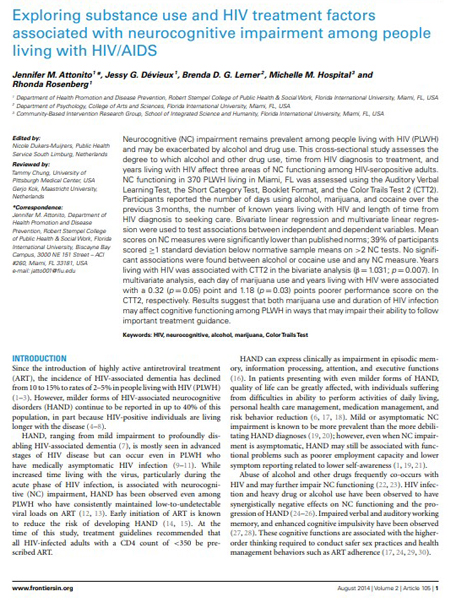 Abstract: Neurocognitive (NC) impairment remains prevalent among people living with HIV (PLWH) and may be exacerbated by alcohol and drug use. This cross-sectional study assesses the degree to which alcohol and other drug use, time from HIV diagnosis to treatment, and years living with HIV affect three areas of NC functioning among HIV-seropositive adults. NC functioning in 370 PLWH living in Miami, FL was assessed using the Auditory Verbal Learning Test, the Short Category Test, Booklet Format, and the Color Trails Test 2 (CTT2). Participants reported the number of days using alcohol, marijuana, and cocaine over the previous 3 months, the number of known years living with HIV and length of time from HIV diagnosis to seeking care. Bivariate linear regression and multivariate linear regression were used to test associations between independent and dependent variables. Mean scores on NC measures were significantly lower than published norms; 39% of participants scored ≥1 standard deviation below normative sample means on >2 NC tests. No significant associations were found between alcohol or cocaine use and any NC measure. Years living with HIV was associated with CTT2 in the bivariate analysis (β = 1.031; p = 0.007). In multivariate analysis, each day of marijuana use and years living with HIV were associated with a 0.32 (p = 0.05) point and 1.18 (p = 0.03) points poorer performance score on the CTT2, respectively. Results suggest that both marijuana use and duration of HIV infection may affect cognitive functioning among PLWH in ways that may impair their ability to follow important treatment guidance.
Abstract: Neurocognitive (NC) impairment remains prevalent among people living with HIV (PLWH) and may be exacerbated by alcohol and drug use. This cross-sectional study assesses the degree to which alcohol and other drug use, time from HIV diagnosis to treatment, and years living with HIV affect three areas of NC functioning among HIV-seropositive adults. NC functioning in 370 PLWH living in Miami, FL was assessed using the Auditory Verbal Learning Test, the Short Category Test, Booklet Format, and the Color Trails Test 2 (CTT2). Participants reported the number of days using alcohol, marijuana, and cocaine over the previous 3 months, the number of known years living with HIV and length of time from HIV diagnosis to seeking care. Bivariate linear regression and multivariate linear regression were used to test associations between independent and dependent variables. Mean scores on NC measures were significantly lower than published norms; 39% of participants scored ≥1 standard deviation below normative sample means on >2 NC tests. No significant associations were found between alcohol or cocaine use and any NC measure. Years living with HIV was associated with CTT2 in the bivariate analysis (β = 1.031; p = 0.007). In multivariate analysis, each day of marijuana use and years living with HIV were associated with a 0.32 (p = 0.05) point and 1.18 (p = 0.03) points poorer performance score on the CTT2, respectively. Results suggest that both marijuana use and duration of HIV infection may affect cognitive functioning among PLWH in ways that may impair their ability to follow important treatment guidance.
Attonito, J.M., DéVieux, J.G., Lerner, B.D., Hospital, M.M., & Rosenberg, R. (2014). Exploring substance use and HIV treatment factors associated with neurocognitive impairment among people living with HIV/AIDS. Frontiers in Public Health, 2, 1-8. doi:10.3389/fpubh.2014.00105
Maternal and peer influences on drinking among Latino college students
Maternal and peer influences on drinking among Latino college students
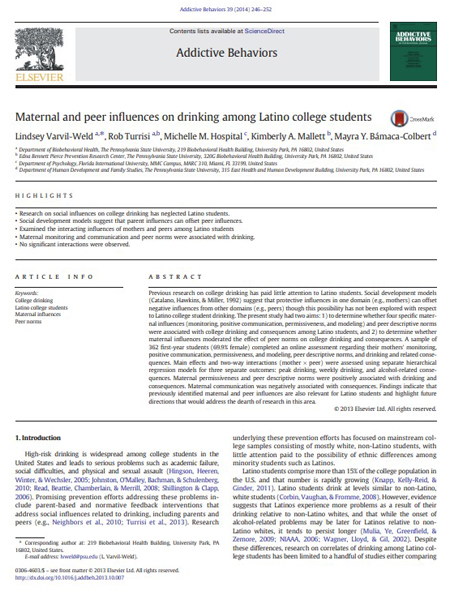 Abstract: Previous research on college drinking has paid little attention to Latino students. Social development models (Catalano, Hawkins, & Miller, 1992) suggest that protective influences in one domain (e.g., mothers) can offset negative influences from other domains (e.g., peers) though this possibility has not been explored with respect to Latino college student drinking. The present study had two aims: 1) to determine whether four specific maternal influences (monitoring, positive communication, permissiveness, and modeling) and peer descriptive norms were associated with college drinking and consequences among Latino students, and 2) to determine whether maternal influences moderated the effect of peer norms on college drinking and consequences. A sample of 362 first-year students (69.9% female) completed an online assessment regarding their mothers’ monitoring, positive communication, permissiveness, and modeling, peer descriptive norms, and drinking and related consequences. Main effects and two-way interactions (mother×peer) were assessed using separate hierarchical regression models for three separate outcomes: peak drinking, weekly drinking, and alcohol-related consequences. Maternal permissiveness and peer descriptive norms were positively associated with drinking and consequences. Maternal communication was negatively associated with consequences. Findings indicate that previously identified maternal and peer influences are also relevant for Latino students and highlight future directions that would address the dearth of research in this area.
Abstract: Previous research on college drinking has paid little attention to Latino students. Social development models (Catalano, Hawkins, & Miller, 1992) suggest that protective influences in one domain (e.g., mothers) can offset negative influences from other domains (e.g., peers) though this possibility has not been explored with respect to Latino college student drinking. The present study had two aims: 1) to determine whether four specific maternal influences (monitoring, positive communication, permissiveness, and modeling) and peer descriptive norms were associated with college drinking and consequences among Latino students, and 2) to determine whether maternal influences moderated the effect of peer norms on college drinking and consequences. A sample of 362 first-year students (69.9% female) completed an online assessment regarding their mothers’ monitoring, positive communication, permissiveness, and modeling, peer descriptive norms, and drinking and related consequences. Main effects and two-way interactions (mother×peer) were assessed using separate hierarchical regression models for three separate outcomes: peak drinking, weekly drinking, and alcohol-related consequences. Maternal permissiveness and peer descriptive norms were positively associated with drinking and consequences. Maternal communication was negatively associated with consequences. Findings indicate that previously identified maternal and peer influences are also relevant for Latino students and highlight future directions that would address the dearth of research in this area.
Varvil-Weld, L., Turrisi, R., Hospital, M.M., Mallett, K.A., & Bámaca-Colbert, M.Y. (2014). Maternal and peer influences on drinking among Latino college students. Addictive Behaviors, 39(1), 246-252. doi:10.1016/j.addbeh.2013.10.007
Mechanisms of association between paternal alcoholism and abuse of alcohol and other illicit drugs among adolescents
Mechanisms of association between paternal alcoholism and abuse of alcohol and other illicit drugs among adolescents
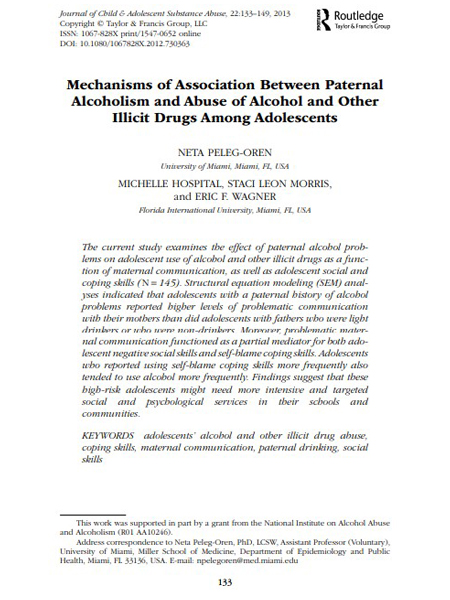 Abstract: The current study examines the effect of paternal alcohol problems on adolescent use of alcohol and other illicit drugs as a function of maternal communication, as well as adolescent social and coping skills (N = 145). Structural equation modeling (SEM) analyses indicated that adolescents with a paternal history of alcohol problems reported higher levels of problematic communication with their mothers than did adolescents with fathers who were light drinkers or who were non-drinkers. Moreover, problematic maternal communication functioned as a partial mediator for both adolescent negative social skills and self-blame coping skills. Adolescents who reported using self-blame coping skills more frequently also tended to use alcohol more frequently. Findings suggest that these high-risk adolescents might need more intensive and targeted social and psychological services in their schools and communities.
Abstract: The current study examines the effect of paternal alcohol problems on adolescent use of alcohol and other illicit drugs as a function of maternal communication, as well as adolescent social and coping skills (N = 145). Structural equation modeling (SEM) analyses indicated that adolescents with a paternal history of alcohol problems reported higher levels of problematic communication with their mothers than did adolescents with fathers who were light drinkers or who were non-drinkers. Moreover, problematic maternal communication functioned as a partial mediator for both adolescent negative social skills and self-blame coping skills. Adolescents who reported using self-blame coping skills more frequently also tended to use alcohol more frequently. Findings suggest that these high-risk adolescents might need more intensive and targeted social and psychological services in their schools and communities.
Peleg-Oren, N., Hospital, M., Morris, S.L., & Wagner, E.F. (2013). Mechanisms of association between paternal alcoholism and abuse of alcohol and other illicit drugs among adolescents. Journal Of Child & Adolescent Substance Abuse, 22(2), 133-149. doi:10.1080/1067828X.2012.730363
Treatment process predictors of program completion or dropout among minority adolescents enrolled in a brief motivational substance abuse intervention
Treatment process predictors of program completion or dropout among minority adolescents enrolled in a brief motivational substance abuse intervention
 Abstract: This study documents significant differences in alliance in a predominantly Latino sample of adolescents who either completed or dropped out of a Guided Self-Change treatment program. Therapeutic alliance, working alliance, and patient involvement were assessed via ratings of audio-recorded segments of participants’ counseling sessions. Descriptive discriminant function analysis identified working alliance goals, patient participation, and therapist warmth and friendliness variables as significantly predictive of completion status. These results were confirmed via follow-up logistic regression analyses. The use of brief clinical tools to monitor and manage alliance among adolescents receiving treatment who are at risk for dropout is discussed.
Abstract: This study documents significant differences in alliance in a predominantly Latino sample of adolescents who either completed or dropped out of a Guided Self-Change treatment program. Therapeutic alliance, working alliance, and patient involvement were assessed via ratings of audio-recorded segments of participants’ counseling sessions. Descriptive discriminant function analysis identified working alliance goals, patient participation, and therapist warmth and friendliness variables as significantly predictive of completion status. These results were confirmed via follow-up logistic regression analyses. The use of brief clinical tools to monitor and manage alliance among adolescents receiving treatment who are at risk for dropout is discussed.
Cordaro, M., Tubman, J.G., Wagner, E.F., & Morris, S.L. (2012). Treatment process predictors of program completion or dropout among minority adolescents enrolled in a brief motivational substance abuse intervention. Journal of Child & Adolescent Substance Abuse, 21(1), 51-68. doi:10.1080/1067828X.2012.636697
Trauma among lesbians and bisexual girls in the juvenile justice system
Trauma among lesbians and bisexual girls in the juvenile justice system
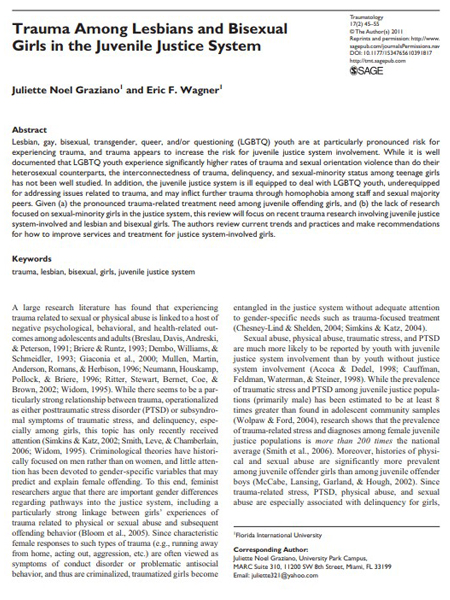 Abstract: Lesbian, gay, bisexual, transgender, queer, and/or questioning (LGBTQ) youth are at particularly pronounced risk for experiencing trauma, and trauma appears to increase the risk for juvenile justice system involvement. While it is well documented that LGBTQ youth experience significantly higher rates of trauma and sexual orientation violence than do their heterosexual counterparts, the interconnectedness of trauma, delinquency, and sexual-minority status among teenage girls has not been well studied. In addition, the juvenile justice system is ill equipped to deal with LGBTQ youth, underequipped for addressing issues related to trauma, and may inflict further trauma through homophobia among staff and sexual majority peers. Given (a) the pronounced trauma-related treatment need among juvenile offending girls, and (b) the lack of research focused on sexual-minority girls in the justice system, this review will focus on recent trauma research involving juvenile justice system-involved and lesbian and bisexual girls. The authors review current trends and practices and make recommendations for how to improve services and treatment for justice system-involved girls.
Abstract: Lesbian, gay, bisexual, transgender, queer, and/or questioning (LGBTQ) youth are at particularly pronounced risk for experiencing trauma, and trauma appears to increase the risk for juvenile justice system involvement. While it is well documented that LGBTQ youth experience significantly higher rates of trauma and sexual orientation violence than do their heterosexual counterparts, the interconnectedness of trauma, delinquency, and sexual-minority status among teenage girls has not been well studied. In addition, the juvenile justice system is ill equipped to deal with LGBTQ youth, underequipped for addressing issues related to trauma, and may inflict further trauma through homophobia among staff and sexual majority peers. Given (a) the pronounced trauma-related treatment need among juvenile offending girls, and (b) the lack of research focused on sexual-minority girls in the justice system, this review will focus on recent trauma research involving juvenile justice system-involved and lesbian and bisexual girls. The authors review current trends and practices and make recommendations for how to improve services and treatment for justice system-involved girls.
Graziano, J.N., & Wagner, E.F. (2011). Trauma among lesbians and bisexual girls in the juvenile justice system. Traumatology, 17(2), 45-55. doi:10.1177/1534765610391817
Motivation for reducing substance use among minority adolescents: Targets for intervention
Motivation for reducing substance use among minority adolescents: Targets for intervention
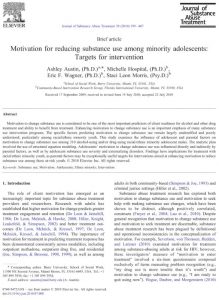 Abstract: Motivation to change substance use is considered to be one of the most important predictors of client readiness for alcohol and other drug treatment and ability to benefit from treatment. Enhancing motivation to change substance use is an important emphasis of many substance use intervention programs. The specific factors predicting motivation to change substance use remain largely unidentified and poorly understood, particularly among racial/ethnic minority youth. This study examines the influence of adolescent and parental factors on motivation to change substance use among 310 alcohol-using and/or drug-using racial/ethnic minority adolescent males. The analytic plan involved the use of structural equation modeling. Adolescents’ motivation to change substance use was influenced directly and indirectly by parental factors, as well as by adolescent substance use severity and externalizing disorders. Findings have implications for treatment with racial/ethnic minority youth, as parental factors may be exceptionally useful targets for interventions aimed at enhancing motivation to reduce substance use among these at-risk youth.
Abstract: Motivation to change substance use is considered to be one of the most important predictors of client readiness for alcohol and other drug treatment and ability to benefit from treatment. Enhancing motivation to change substance use is an important emphasis of many substance use intervention programs. The specific factors predicting motivation to change substance use remain largely unidentified and poorly understood, particularly among racial/ethnic minority youth. This study examines the influence of adolescent and parental factors on motivation to change substance use among 310 alcohol-using and/or drug-using racial/ethnic minority adolescent males. The analytic plan involved the use of structural equation modeling. Adolescents’ motivation to change substance use was influenced directly and indirectly by parental factors, as well as by adolescent substance use severity and externalizing disorders. Findings have implications for treatment with racial/ethnic minority youth, as parental factors may be exceptionally useful targets for interventions aimed at enhancing motivation to reduce substance use among these at-risk youth.
Austin, A., Hospital, M., Wagner, E.F., & Morris, S.L. (2010). Motivation for reducing substance use among minority adolescents: Targets for intervention. Journal Of Substance Abuse Treatment, 39(4), 399-407. doi:10.1016/j.jsat.2010.07.008
Maltreatment clusters among youth in outpatient substance abuse treatment: Co-occurring patterns of psychiatric symptoms and sexual risk behaviors
Maltreatment clusters among youth in outpatient substance abuse treatment: Co-occurring patterns of psychiatric symptoms and sexual risk behaviors
 Abstract: The purpose of the current study was to describe the use of a brief maltreatment assessment instrument to classify adolescents receiving alcohol or other drug (AOD) treatment services based on the extensiveness and severity of prior maltreatment. This goal is significant because maltreatment reduces the effectiveness of AOD treatment and is associated significantly with co-occurring patterns of psychiatric symptoms and sexual risk behaviors. Structured interviews were administered to 300 adolescent treatment clients (202 males, 98 females; M = 16.22 years; SD = 1.13 years) to assess childhood maltreatment experiences, past year psychiatric symptoms, and sexual risk behaviors during the past 180 days. Cluster analysis classified adolescents into unique groups via self-reported sexual abuse, physical punishment, and parental neglect/negative home environment. Significant between-cluster differences in psychiatric symptoms and sexual risk behaviors were documented using MANOVA and chi-square analyses. More severe maltreatment profiles were associated with higher scores for psychiatric symptoms and unprotected intercourse. Significant heterogeneity and distinct types within this treatment sample of adolescents supports the adaptation of selected prevention efforts to promote HIV/STI risk reduction.
Abstract: The purpose of the current study was to describe the use of a brief maltreatment assessment instrument to classify adolescents receiving alcohol or other drug (AOD) treatment services based on the extensiveness and severity of prior maltreatment. This goal is significant because maltreatment reduces the effectiveness of AOD treatment and is associated significantly with co-occurring patterns of psychiatric symptoms and sexual risk behaviors. Structured interviews were administered to 300 adolescent treatment clients (202 males, 98 females; M = 16.22 years; SD = 1.13 years) to assess childhood maltreatment experiences, past year psychiatric symptoms, and sexual risk behaviors during the past 180 days. Cluster analysis classified adolescents into unique groups via self-reported sexual abuse, physical punishment, and parental neglect/negative home environment. Significant between-cluster differences in psychiatric symptoms and sexual risk behaviors were documented using MANOVA and chi-square analyses. More severe maltreatment profiles were associated with higher scores for psychiatric symptoms and unprotected intercourse. Significant heterogeneity and distinct types within this treatment sample of adolescents supports the adaptation of selected prevention efforts to promote HIV/STI risk reduction.
Tubman, J.G., Oshri, A., Taylor, H.L., & Morris, S.L. (2011). Maltreatment clusters among youth in outpatient substance abuse treatment: Co-occurring patterns of psychiatric symptoms and sexual risk behaviors. Archives Of Sexual Behavior, 40(2), 301-309. doi:10.1007/s10508-010-9699-8
Markers of marijuana use outcomes within adolescent substance abuse group treatment
Markers of marijuana use outcomes within adolescent substance abuse group treatment
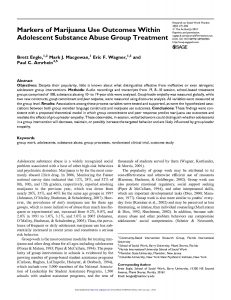 Abstract/Objectives: Despite their popularity, little is known about what distinguishes effective from ineffective or even iatrogenic adolescent group interventions.
Abstract/Objectives: Despite their popularity, little is known about what distinguishes effective from ineffective or even iatrogenic adolescent group interventions.
Methods: Audio recordings and transcripts from 19, 8—10 session, school-based treatment groups comprised of 108, substance abusing 10- to 19-year olds were analyzed. Group leader empathy was measured globally, while two new constructs, group commitment and peer response, were measured using discourse analysis. All variables were measured at the group level.
Results: Associations among these process variables were tested and supported, as were the hypothesized associations between both group member language constructs and marijuana use outcomes.
Conclusions: These findings were consistent with a proposed theoretical model in which group commitment and peer response predict marijuana use outcomes and mediate the effects of group leader empathy. These observable, in-session, verbal behaviors could distinguish whether adolescents in a group intervention will decrease, maintain, or possibly increase the targeted behavior and are likely influenced by group leader empathy.
Engle, B., Macgowan, M.J., Wagner, E.F., & Amrhein, P.C. (2010). Markers of marijuana use outcomes within adolescent substance abuse group treatment. Research on Social Work Practice, 20(3), 271-282. doi:10.1177/1049731509347855
